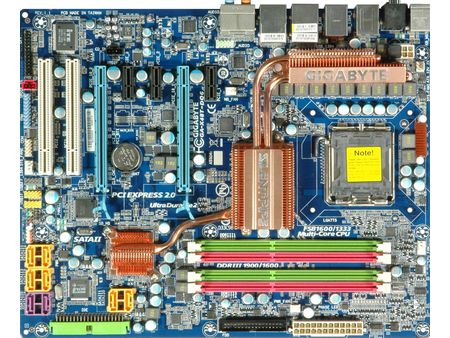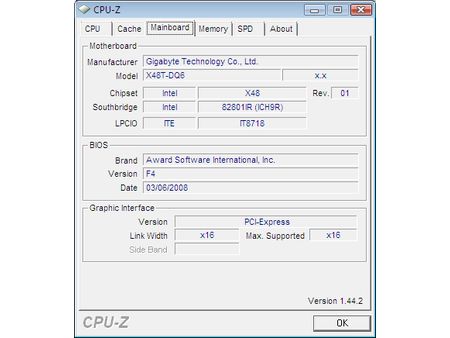High-End Chipset Battle
Intel X48: Gigabyte X48T-DQ6
BIOS version: F7
As mentioned in our introduction, we used a Gigabyte X48T-DQ6 to represent Intel’s X48 chipset. The DQ6 family is Gigabyte’s top model, offering a 12-phase voltage regulator. There are massive copper coolers and a copper heat pipe connecting the voltage regulators, the northbridge and the southbridge. The two x16 PCI Express 2.0 slots are blue; there are more x1 PCI Express slots, and two 32-bit PCI slots are available for add-in cards (these are black and white). Gigabyte didn’t want to offer only the six SATA/300 ports of the ICH9R southbridge, so it put an additional controller on the motherboard, which provides two more SATA ports and an UltraATA/133 channel. The latter is important for legacy hard drives or optical drives. eSATA is supported via a separate slot panel.
If you still have a non-USB keyboard or mouse then you’ll be happy to find PS/2 connectors on the back panel. There we also found optical and coaxial digital audio outputs, standard audio jacks, two Gigabit Ethernet ports, a Firewire port and as many as eight USB 2.0 ports — four more are on the motherboard, but those require a slot adapter.
The energy-saving feature called Dynamic Energy Saver (DES) enables or disables voltage regulator phases depending on the processor load. Using a large number of phases ensures reliable voltage supply at high-performance environments, but it decreases power efficiency. With DES, the system switches off up to eight of the 12 phases, even when using a Core 2 Extreme QX6850. DES, however, requires a driver and software to be installed, so it can monitor the CPU load.
The CPU Throttling Feature is supposed to help to further reduce power consumption, but it reduces system performance noticeably: we found that WinRAR took 2:40 instead of 2:10, and we didn’t detect any reduction in power consumption either. These are the power requirement levels using DES and its various settings:
IdleDES Off 12 Phase = 105WDES Level 1 Normal 6 Phase = 100W DES Level 2; Advanced Power Savings 6 Phase = 100W DES Level 3; Extreme Power Savings 4 Phase = 94W
Load (using Prime95)DES Off 12 Phase = 201WDES Level 1 Normal 6 Phase = 191W DES Level 2; Advanced Power Savings 6 Phase = 187W DES Level 3; Extreme Power Savings 4 Phase = 180W
Get Tom's Hardware's best news and in-depth reviews, straight to your inbox.
Please be aware that you can either use the EasyTune overclocking utility, or enable the DES power saving mechanism: combining both isn’t possible, which we believe is a shame. Even when overclocked, there are ways to avoid unnecessary power draw. EasyTune is based on a graphically overloaded interface, but it allows you to tweak and overclock all the major settings in order to overclock the system without having to go into the old-fashioned BIOS.
We reached FSB2100 speed on this motherboard, which is 100 MHz faster than the maximum system speed on the nForce 790i Ultra SLI motherboard by Asus. FSB1800 can be reached without any modifications: just select the FSB speed and leave everything else on auto.


